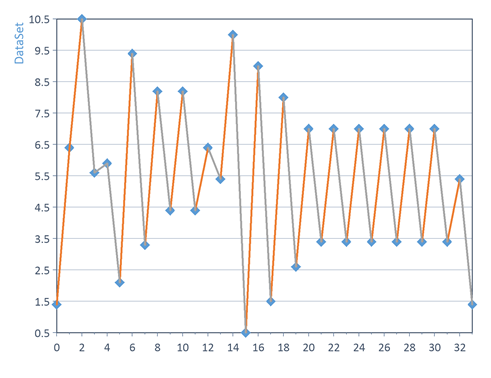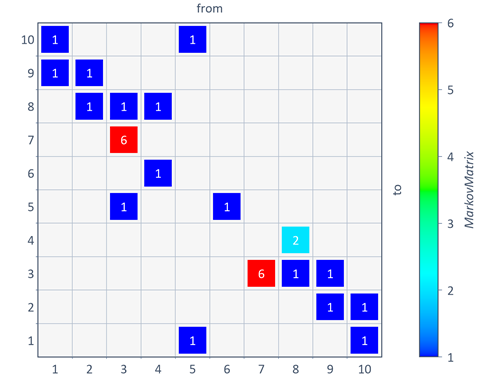MarkovMatrix (FPScript)
Determines the Markov Matrix (transition matrix) for a data set.
Syntax
MarkovMatrix(DataSet, ClassLimits, Hysteresis)
The syntax of the MarkovMatrix function consists of the following parts:
Part |
Description |
|---|---|
DataSet |
The data set to which a Markov matrix is to be determined. Permitted data structures are data series und signal. All real data types are permitted. If the argument is a list, then the function is executed for each element of the list and the result is also a list. |
ClassLimits |
Contains a data series, which contains the class limits for the count. If ClassLimits contains n values, this leads to n-1 closed classes. The first or the last value in ClassLimits provides the lowest or highest limit of the class division. Values that lie outside the limits are not counted. Permitted data structures are data series. All real data types are permitted. The unit has to be compatible with that of parameter DataSet. If the argument is a list, then the first element in the list is taken. If this is also a list, then the process is repeated. |
Hysteresis |
Specifies a hysteresis (range filter), which leads to suppression of small load alternations around a class limit. Only the crossings where the absolute value is as least as high as the hysteresis are counted. Permitted data structures are scalar value. All real data types are permitted. The unit has to be compatible with that of parameter DataSet. If the argument is a list, then the first element in the list is taken. If this is also a list, then the process is repeated. |
Remarks
The DataSet and ClassLimits types should be the same. If this is not the case, then these are adapted to each other. If a data series was specified as DataSet, the result is a data matrix of 64-bit integer values with the Markov matrix. The rows in the matrix (value index in the data matrix) correspond to the "from" classes of the crossings and the columns correspond to the "to" classes. If DataSet was specified as a signal, the result is a signal series with a Z component, whose X and Y components contain the class mid-points resulting from the class limits.
Available in
Option Counting Procedures
Examples
MarkovMatrix(Signal(DataSet, 1), (11., Minimum(DataSet), Range(DataSet) / 10.), Range(DataSet) / 10. * 0.01)
Calculates the Markov matrix of the 'DataSet' data series with 10 classes of equal size. The counted transitions are alternately highlighted in red and blue.


